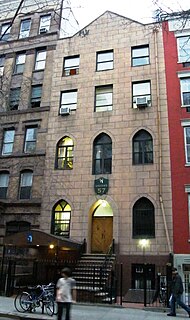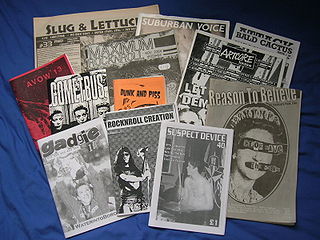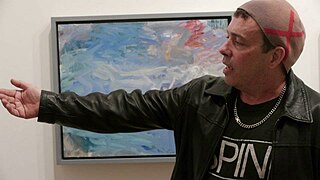No wave was a transient avant-garde music and visual art scene of the late 1970s in downtown New York City. Reacting against punk rock's recycling of rock and roll clichés, no wave musicians instead experimented with noise, dissonance and atonality in addition to non-rock genres like free jazz and disco while often reflecting an abrasive, confrontational, and nihilistic worldview.
Bush Tetras are an American post-punk band from New York City, formed in 1979. They are best known for the 1980 song "Too Many Creeps", which exemplified the band's sound of "jagged rhythms, slicing guitars, and sniping vocals". Although they did not achieve mainstream success, the Bush Tetras were influential and popular in the Manhattan club scene and college radio in the early 1980s. New York's post-punk revival of the 2000s was accompanied by a resurgence of interest in the genre, with the Tetras' influence heard in many of that scene's bands.

The Mudd Club was a nightclub located at 77 White Street in the TriBeCa neighborhood of Lower Manhattan in New York City. It operated from 1978 to 1983 as a venue for underground music and counterculture events. It was opened by Steve Mass, Diego Cortez and Anya Phillips.
John McLoughlin, better known by the stage name John Sex, was an American cabaret singer and performance artist in New York City from the late 1970s until his death in late 1990.

Ann Magnuson is an American actress, performance artist, and nightclub performer. She was described by The New York Times in 1990 as "An endearing theatrical chameleon who has as many characters at her fingertips as Lily Tomlin does".

Club 57 was a nightclub located at 57 St. Mark's Place in the East Village, New York City during the late 1970s and early 1980s. It was originally founded by Stanley Zbigniew Strychacki and enhanced by nightclub performer Ann Magnuson, Susan Hannaford, and poet Tom Scully. It was a hangout and venue for performance and visual artists and musicians, including The Cramps, Madonna, Keith Haring, Cyndi Lauper, Charles Busch, Klaus Nomi, The B-52s, RuPaul, Futura 2000, Tron von Hollywood, Kenny Scharf, Frank Holliday, John Sex, Wendy Wild, The Fall, April Palmieri, Peter Kwaloff, Robert Carrithers, The Fleshtones, The Fuzztones, Joey Arias, Lypsinka, Michael Musto, Marc Shaiman, Scott Wittman, Fab Five Freddy, Jacek Tylicki, and to a lesser extent, Jean-Michel Basquiat.

Punk visual art is artwork associated with the punk subculture and the No wave movement. It is prevalent in punk rock album covers, flyers for punk concerts and punk zines, but has also been prolific in other mediums, such as the visual arts, the performing arts, literature and cinema. Punk manifested itself "differently but consistently" in different cultural spheres. Punk also led to the birth of several movements: new wave, no wave, dark wave, industrial, hardcore, queercore, etc., which are sometimes showcased in art galleries and exhibition spaces. The punk aesthetic was a dominant strand from 1982 to 1986 in the many art galleries of the East Village of Manhattan.

Frank Holliday is an American painter who became known in the New York City art world in the 1970s and 1980s. He is often associated with the East Village scene and associated with Club 57. His early career as an artist included working with Andy Warhol and close associations with artists such as Keith Haring Ann Magnuson and Kenny Scharf.
Wendy Wild was an American singer, musician, and artist who in the 1980s was a well-known presence in New York's downtown music and performance scenes.

Carlo McCormick is an American culture critic and curator living in New York City. He is the author of numerous books, monographs and catalogues on contemporary art and artists.

Irving Kriesberg was an American painter, sculptor, educator, author, and filmmaker, whose work combined elements of Abstract Expressionism with representational human, animal, and humanoid forms. Because Kriesberg blended formalist elements with figurative forms he is often considered to be a Figurative Expressionist.
Riot grrrl is an underground feminist punk movement that began during the early 1990s within the United States in Olympia, Washington and the greater Pacific Northwest and has expanded to at least 26 other countries. Riot grrrl is a subcultural movement that combines feminism, punk music, and politics. It is often associated with third-wave feminism, which is sometimes seen as having grown out of the riot grrrl movement and has recently been seen in fourth-wave feminist punk music that rose in the 2010s. The genre has also been described as coming out of indie rock, with the punk scene serving as an inspiration for a movement in which women could express themselves the same way men have been doing all along. To quote Liz Naylor, who would become the manager of riot grrrl band Huggy Bear:
There was a lot of anger and self-mutilation. In a symbolic sense, women were cutting and destroying the established image of femininity, aggressively tearing it down.
Eric Mitchell is a French born writer, director and actor who moved to downtown New York City in the early 1970s. He has acted in many No Wave films such as Permanent Vacation (1980) by Jim Jarmusch, but is best known for his own films that are usually writing and directed by him: Kidnapped, Red Italy, Underground U.S.A. and The Way It Is or Eurydice in the Avenues, starring Steve Buscemi, Vincent Gallo, Mark Boone Junior and Rockets Redglare. Mitchell worked out of New York City's sordid East Village area in conjunction with Colab and other performance artists and noise musicians. There he created a series of scruffy, deeply personal, short Super 8mm and 16mm films in which he combined darkly sinister images to explore the manner in which the individual is constrained by society.
James Allan Curtis, known professionally as Diego Cortez, was an American filmmaker and art curator closely associated with the no wave period in New York City. Cortez was the co-founder of the Mudd Club, and he curated the influential post-punk art show New York/New Wave, which brought the then aspiring artist Jean-Michel Basquiat to fame.
Tessa Hughes-Freeland is a British-born experimental film maker, writer living in New York City. Her films have screened internationally in North America, Europe and Australia and in prominent museums and galleries, including the Museum of Modern Art (MOMA); the Museum of Contemporary Art, Los Angeles; the Whitney Museum of American Art; the New Museum of Contemporary Art in New York; and the KW Institute of Contemporary Art in Berlin. She has collaborated on live multi-media projects with musicians like John Zorn and J. G. Thirlwell. She and Ela Troyano co-founded the New York Film Festival Downtown in 1984 and served as its co-directors until 1990. Hughes-Freeland later served as President of the Board of Directors of the Film-Makers Co-Operative in New York City from 1998-2001. She has published articles in numerous books, including “Naked Lens: Beat Cinema” and “No Focus: Punk Film,” and in periodicals including PAPER Magazine, Filmmaker magazine, GQ, the East Village Eye, and Film Threat.
GoNightclubbing is a collaboration between video artists Pat Ivers and Emily Armstrong, who worked together to document the New York punk rock scene beginning in 1977. Ivers had previously worked with Metropolis Video from 1975 until their dissolution in 1977. Originally, Ivers and Armstrong were known as Advanced TV, but they incorporated as GoNightclubbing in 2001.
Marty Greenbaum was an American painter, mixed media assemblage and book artist.
New York/New Wave was an exhibition curated by Diego Cortez in 1981. Held at the Long Island City gallery P.S.1, it documented the crossover between the downtown art and music scenes. The show featured a coalition of No Wave musicians, painters, graffiti artists, poets, and photographers.

The Offenders is a 1980 American No Wave color Super 8 film directed by Scott B and Beth B that, as a punk melodrama, post-modernly refers back to the 1921 melodrama film The Offenders directed by Fenwicke L. Holmes. It originally was presented as a serial that screened at Max's Kansas City and the Mudd Club whereby each week the attendees paid for the making of next week's episodes.

Pulsallama was an all-woman, no wave band from New York. Described as "13 girls fighting over a cowbell," the post-punk group was primarily a percussion ensemble with two bass guitars and several vocalists. The band was formed in early 1981 from the Ladies Auxiliary of the Lower East Side, a performance art group that had its beginnings at Club 57. Ann Magnuson, Wendy Wild, and April Palmieri were among the members of the band.









